Author(s): <p>Neim Semman AbaDura</p>
Ever increasing human population in addition with global climate change, expansion of urban and shrinking of cultivable land, persistence of crop pests and diseases are contributing to sever starvation. Feeding of these population require more than double yield increment than the current situation. This can take for conventional plant breeding a long time which is a game of molecular improvement mechanism within a short period of time. So, this paper emphasized assay of on achievements of root and tuber crops improvement through modifying undesired gene traits to desirable. Root and tuber crops are the mainstay of majority of SSA where mainly cultivated for consumption. However, different production challenges such as biotic and abiotic factors and anti-nutritional factors of some crops hinder production and consumption. To tackle these problem different scientists and researchers exerted efforts of developing transgenic crops and successful results were reported on potato, cassava and taro resistant to different insect pests, diseases, drought and salinity. Additionally, inhibition of toxic substances in cassava and taro, increasing of nutritional composition such as vitamin, protein and improving postharvest storability via deactivating responsible enzymes. Even though large works had been done, comparative to other cereal crops, no more attention were given to root and tuber crops. Besides of modifying genetics of the crop the side effects it has on environment and other organism were not more touched. So, to realize food self-sufficiency doing on high yielding crop per piece of acre and side by side evaluation of effect to be occurring is recommended.
Root and tuber crops are the main diet of millions in SSA where predominant residents are undernourished. The main root and tuber food crops include cassava (Manihot esculenta), Potato (Solanum tuberosum), Taro (colocaseae esculenta), Sweet potatoes (Impomoea batatus) which reproduce in vegetative [1]. They are major starch sources comprising a botanically diverse group of starchy staples that are very important for food and agriculture [2]. These crops are indispensible in ensuring food security providing high yield as compared to cereal crops [3]. However, majority of root crops have different production constraints and drawback which discourage producers and consumers. Among these problems; susceptibility to many disease and insect pests, anti-nutritional factors, limited contribution of other nutrients like carotenoid, vitamin and protein contents are few of them. For example, in root of cassava it was confirmed that toxic cyanogen content contributed to reduced production and consumption in most producing areas [4]. Additionally, with current climate change, there are lacks of stress tolerant root crops as compared to developed multipurpose cereal crops through extensive research emphasis provided.
Improvements of crops and development of new varieties contributes significant roles in crop production and livelihood of poor farmers. Since long decades, traditional breeding has contributed trait improvement in numbers of crops including root and tuber crops through boosting yield depending on population gene pools. Clonally propagated crops accumulate and transmit pathogen and in order to overcome such problems, transgenic approach became an alternative to meet demand with high-yield, nutritionally balanced and biotic and abiotic tolerant crops.
Most plant breeding programs targeted to improve different plant traits in order to boost yield and increase resistant to abiotic and biotic factors as well as quality characteristics. With the expansion of urban, limited water, shrinking of productivity land and population increment, satisfying of human food problem is a key issue. In genomic epoch, advances in molecular breeding have opened new opportunities in plant breeding processes and in addressing above mentioned bottlenecks [5]. So, there is need of linkage between molecular methods with breeding objectives so as potential of recent advances in biotechnology and genomics fully realized [6]. Today, there are two mechanisms for molecular improvement depending on origin of variability viz. hybridization of genotypes (the classical), genetic transformation.
There are also different sophisticated mechanisms of crop improvement: such as genome editing techniques which is the process where an organism’s genetic code is changed.
Restriction enzymes: the ability to edit genes became a reality with discovery of restriction enzyme which recognize specific patterns of nucleotide sequences and cut at that site providing opportunity to insert new DNA materials at that location. It was discovered in 1970. But not used to day in genome editing but in gene cloning.
Discovered in 1980. It composed of an engineered nuclease fused to zinc finger DNA-binding domains increasing the length of the DNA recognition site consequently increasing length of DNA recognition site. It uses Folk nuclease to cut DNA and require dimerization to function.
Improvement over ZFNs emerged in 2011 and this also uses Folk nuclease to cut DNA and require dimerization to function. In this case amino acid repeats possess single nucleotide recognition, thereby increasing targeting capabilities and specificity compared to ZFNs.
In 2012 forwarded but in 2013 was recognized how to use by Feng Zhang. It was long been existed in bacteria to help them fight off invading virus. CRISPR is two component systems consisting of guide RNA and a Cas 9 nuclease which cut DNA within 20 nucleotide region defined by the guide RNA.
There has been a desire to develop of crops for food, feed, fuel and fun along with anti-nutritional factors or improvements to the health properties [2]. Also to develop climate smart crops, plant breeding in collaboration of biotechnological and digital revolution is required.
Genetic engineering shows great potential in germplasm innovation by improving specific traits without changing in other desired attributes specifically with development of genome editing technology [4].
So, to fill such gap, genetic modification through transgenic modification in collaboration with conventional breeding is paramount to address these problems.
The objectives of this paper is to review different works done in advancing yields of root crops through modern genetically modification to boost yield, adding values through transgenic in solving food problems and malnutrition in general.
Production of root and tuber crops have multipurpose for growers, traders and consumers in chain being as a source of cash income, insuring food security, filling food gap during food scares and majority of them are high source of starch and carbohydrate [3]. Being the main sources of minerals, vitamin and source of industrial input make it prominent. The crop render considerable yield under poor management and high yielder per small acre [9]. Tubers and leafy tops of majority of root and tuber crops are edible providing staple food and medicinal values. Tuber and leafof sweet potatoes are used as food in many countries worldwide [10]. The yellow and orange fleshed contain carotenoids making it rich sources of carotein, and have different types of vitamins (A and C). The plants used as sources of animal feed, energy sources.
In the ever increasing human population and the new concern connected with global climate change and increased demand of agricultural raw materials for industry will place enormous influence on natural resources. There are different production challenges including lack of cultivable land, limited irrigation structure, postharvest loss, weeds, insect and disease [11]. Cassava is very important staple crop for food and income and most efficient for production of starch and processed for flour. It is also drought tolerant and can resist or tolerate many of expected impacts from climate change [12].
In the world with adverse environmental conditions and population increment in alarm rate, food insecurity and malnutrition are serious fear causing loss of lives especially in developing countries of SSA. To tackle this concern, world must produce 50-100% food more than at present level. So, this can be achieved through particle bombardment and or Agrobacterium mediated transformation approaches where agrobacterium perceived advantage over the former approach due to few insertion of transgene but large DNA segments. So far, efforts to improve root and tuber crops by genetic transformation concentrated on traits and biotic and abiotic stress such as pests, pathogen, drought, salinity, extreme temperature, quality and yield improvement were done [1]. Such genetic transformation holds promise for introducing novel traits to tubers and root crops.
Cassava is considered as special gift to African people because of its ease of production, high productivities and rich of carbohydrates. However, its production constrained by toxic chemical contents, cyanogenic glycoside varying from 100 to 500 gm/kg of fresh weight depending on cultivars but the maximum level 10 mg CN equivalents/kg dry weight where consumption of 50-100mg or 2mmol HCN can completely block cellular respiration in human [13]. Of all plant parts, leaf contains the highest hydrogen cyanide and transported to root. To reduce cyanogen toxicity of using genetic manipulations, two strategies were implemented. The first is selectively inhibition of the expression of the CYP79D/ D2 genes. To achieve this, the gene CYP79D/D2 that encode the enzyme catalyzing linamarin synthesis were expressed in an antisense orientation driven by leaf and root specific cab1 and other potato patatin promoter respectively. The transgenic plants were generated using Agrobacterium mediated transformation of somatic embryo, and integration of transfer DNA (T-DND) was confirmed by PCR and Southern blot analysis. Quantitative analysis of leaf and root linamarin content by gas chromatography/ mass spectrometry were unaltered for patatin - CYP79D/D2 transgenic whereas linamarin content of Cab1 -CYP79D1/D2 transformant exhibited substantial reduction in root linamarin content to <1% of wild-types. This reduction is not associated with root reduction of CYP79D1/D2 but reduction in leaf cyanogen due to flow of chemical from leaf to root whereas the second was overexpression of HNL in root which facilitate volatilization and detoxification of HCN during processing [12].
Different report indicated about 30% of irrigated agricultural land, which account for 7% of total arable land of the planet is affected by salinity which affect plant through osmotic stress and ionic toxicity. Salt stress retard plant growth reducing plant water potential whereas Sodium ion (Na+) congest to toxic concentration that reduce potassium (K) absorption resulting disorder in physiological and enzyme activity. However, confirmation of HKT gene, which is member of Trk/Ktr/HKT transporter superfamily are reported to be active at plasma membrane exclude Na+ from leaves while increasing K ion to resist salt stress [14]. The authors tested high-affinity potassium transporter (HKT) through transferring Arabidopsis thaliana high-affinity potassium transporter (AtHKT1) gene to potato cultivars using constitutive promoter CaMV 355 hypothesizing the gene reduce accumulation of Na+ and balance K+/Na+ in plant parts. PCR amplification of transformed gene analysis was indicated 1521bp AtHKT1 amplification product integrated to genome of transgenic. Then after field assessment of these transgenic with control plant were done and under different salt (NaCl) concentration. In transgenic plant K+ increased in leaves with increased in salt stress while in control plant the concentration of Na+ increased. After 30 days under 50mmol L-1 Na+ concentration were found 2.2 fold greater than transgenic lines. The authors portrayed that overexpression of AtHKT1 positively correlated with photosynthetic rate, transpiration rate, stomatal conductance and yield related variables. [15] also stated mannitol is an osmo-regulatory substance in plant species which is sugar alcohol in nature. The plant transformed with mannitol-1-phosphate dehydrogenase (mtlD) gene from E.coli showed salinity tolerance.
Conducted assay on tolerability of potato to salt stress by expressing Mannitol, 1-phosphate dehydrogenase gene (mtlD, E.C.1.1.1.17) isolating from pCabmtlD plasmid to create transgenic potato cultivars [16]. Then the features of these transgenic potatoes were evaluated using polymerase chain reaction and physiological assessment (testing under different salt concentration). They discussed significant variation between transgenic and nontransgenic potato in tolerability to salt stress and osmotic pressure in transgenic potato was increased by production of mannitol which approved successful expression of mtlD gene.
There are several root crop improvement programs being carried out worldwide. Among these, improving storability of cassava which is the most nagging challenge of cassava breeder is the crucial. In cassava production, the most complaining situation raised was that short period deterioration of its products. So as to solve this problem, in Nigeria, International Institute for tropical Agriculture /IITA/ is currently approving genetically modified/transgenic cassava for prolonged root storage which resist deterioration using gene-silencing technology which has been never tried previously. The authors and different participant scientists confirming that the new genetically engineered no have portends danger to nations [12]. Once cassava harvested, it should processed within 24hr because of enzymatic activity. The transformed cassava (GE) will deactivate the enzyme that causes deterioration of starch when root are harvested.
Drought is one of the most critical environmental stresses adversely reducing yield and growth affecting morpho-biochemical plant worldwide and the molecular tailoring of genes can facilitate development of improved crops [17]. A lot of efforts were so far done in order to evaluate transgenic potatoes to drought stress.Trehalose is non-reducing disaccharide of glucose and plants that can produce trehalose are always tolerant to desiccation stress. In line with this, inserted trehalose biosynthesis in to potato by introducing the otsA and otsB gene from E. coli which encodes trehalose-6-phosphate synthase and trehalose-6-phosphate phosphatase respectively [18]. Furthermore, Glycine betaine (GB) is one of the most important osmolytes in higher plants to survive within environmental stress by osmotic adjustment. Accumulation of GB in plant serve as response to drought and salinity which supported by sited by who showed transgenic potato plant overexpressing coda and betaine aldehyde dehydrogenase (BADH) gene for GB synthesis were more tolerant to drought stress [19,1].
Some transcriptional factors used in abiotic stress tolerance such as drought. In parity with this, creating transgenic potato with AtDREB1A gene evaluation result was reported, conducted research on drought stress tolerability of wild type (Kemb36 and KSP36) and transgenic sweet potatoes (Jewel which is high transformability and regenerability i.e transgenic with IPT gene which confer resistance mannoose) cultivars [20]. The cultivars were well watered for the first two months and 14 days after drought induction, the wild types started wilting and dropping leaves while the transgenic plants still had upright leaves. The authors reported that after 21 days of stress the wild types displayed leaves senescence while the transgenic one only exhibit wilting. Similarly on recovery the transgenic plant much fast and fully recovered after 9 days of re-watering.
Table 1: Genes Overexpressed in Transgenic Potato Plants for Drought Stress
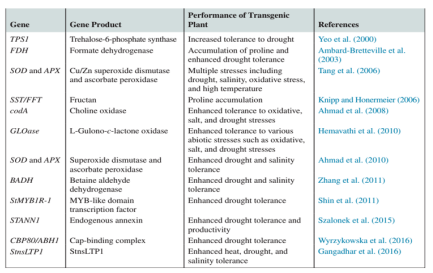
Source: Adapted from [1]
Even though molecular level based plant improvement recently emerged, development of number of root crops resistance to insect pests are being existed. Different evidences detected that about 19 genes for resistance to pathogens and pests had been localized on different potato maps the so called hot spots for resistance [21]. In line with the result, for potato blight disease (phytophtora infestans) which is most devastating, development of potato plants that produce hydrogen peroxide through incorporation of glucose oxidase gene from Aspergillus niger expression. Presence of the enzyme, catalyzes β-D-glucose oxidation with release of gluconic acid and hydrogen peroxide. Also, development of potato having gene for temporin A which is small naturally occurring peptide which boost plant resistance for all wet rot bacterial origin disease. So, transgenic potato plant with this gene was confirmed serving as good tool for control of these diseases. Viruses are a major threat causing massive yield loss and economical damage [1].
Taro one of the food security crop are produced worldwide. However, its production suffered for number of diseases. In most of dry land fungal disease known as blight is serious disease. To combat this disease, transformation of taro with Oxalase Oxidase (OxO) gene gf2.8 from wheat was done. Insertion of this gene was confirmed with PCR and Southern blot analysis. The gene showed great promise of in controlling major taro pathogen P. colocasiae [20].
The other achievement on potato plant affecting insect (Leptinotarsa decemlineata) which is often resistant to chemical insecticide was modified potatoes transformed with gene Cry3A originating from bacteria Bacillus thuringiensis [22].
Potato affecting insect kwon as Colorado potato beetle (CPB) is major defoliator seriously reported throughout northern hemisphere. This pest was controlled by expressing Cry3A protein which was resistant to CPB. Though this protein was available commercially in USA, due to less acceptance for sale the gene was take off the market [1]. Additionally, for sap sucking chewing aphids, transgenic potato with snowdrop lectin (Galanthus nivalis agglutinin (GNA)) confer resistance. Viruses are the yield limiting factor for number of root crops. For this, coat protein (CP) gene mediated resistance in transgenic plants has been reported as effective protection in several plant virus systems. CP-mediated resistances is usually associated to RNA silencing, a mechanism in which the production of double stranded RNA, as an intermediate of viral replication cycle, break the mRNA or blocks its translation [23]. The authors conducted research by translating CP gene virus in 1P and 63P potato clone by virus vector (aphid) to evaluate potato virus Y resistant varieties with non-transgenic parental plants. They reported that, almost all no-transgenic plants showed symptoms of virus infection with percentage of virus dissemination varied from 40 to 90% while none of 1P clone plant and only one 63P clone naturally infected with PVY by virus vector. Based on the result they concluded that, GM potato clones 1P and 63P containing the coat protein gene of potato virus Y are resistant to PVY.
Table 2: Plants of potato clones infected with potato virus Y for three consecutive years

Table 3: Gene overexpressed in transgenic potato plants for pest resistance
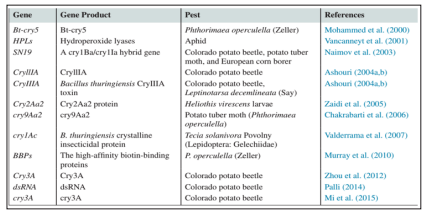
Source: Adapted from [1]
Cassava affected severly by cassava mosaic virus. To overcome this problem, scientists developed RNA based silencing mechanism against virus. This technology was developed to inhibit virus replication through antisense, dsRNA and miRNA. Two genes CMD-1 sourced from interspecific hybrid clones 58308 with Manihot glaziovii Mull. Arg) and CMD-2 from dominant Nigerian landrace ( TMEB3) [4].
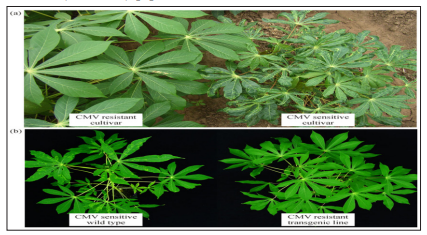
Figure 1: Evaluated cassava plants resistance to cassava mosaic virus (CMV). (a) The field-grown cassava plants resistant or susceptible to CMV; (b) transgenic cassava expressing ACMVAC1 gene-targeted siRNA showed increased resistance to CMV compared to the wild type
Sourced: Extracted from [4].
Table 4: Gene overexpressed in transgenic potato plants for diseases resistance
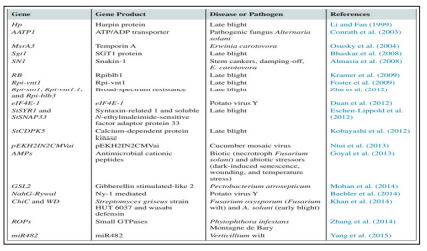
Source: Adapted from [1]
Potato flour in industry is characterized by low elasticity and thus limited in glutenin gene. For this reason, potato plants carrying a gene for low weight glutenin (LMW-GS-MB1) have been produced to improve functional flour qualities. The source of the gene is wheat (triticum aestivum) seed containing this protein. In transgenic potato plant, the accumulation of LMW-GS-MB1 was high and increase in potato flour viscosity [24]. On top of this, potato with high simple sugar deteriorate rapidly at lower storage temperature as they get sweet and turn brown during frying resulting less attractive for consumers. So, the recently genetically modified potato plant in Czech Republic solves this problem. There are potatoes with inserted gene for phosphofructonase from bacterium Lactobacillus bulgaricus where this gene causes degradation of simple sugar via glycolytic pathway. The other GM plant is production of biopharmaceuticals from plants with gene engineering which is cheap production and storage, large-scale manufacture of biopharmaceutical with high health safety [24].
In leading countries in cassava production from Africa and worldwide, in Nigeria and Ghana risk assessment of GM cassava in environmental and health status was undertaken by [1]. For the assessment, scientists from both countries were identified using country’s government. In both counties, scientists agreed that GM cassava is important in improving quality of root and tuber crops. They also emphasized on nutritional benefits, increased yield and disease resistance especially solving problems unsolved through traditional plant breeding technique such as death of children due to chronic malnutrition and poor quality diets such as iron, zink, protein and vitamin A deficiency. In Nigeria and Puerto Rico trial of bio-fortified cassava germplasm for β-carotene and Zink content enhanced cassava were took place.
Cassava is the main source of starch which accumulate large amount in its storage roots. Despite it accumulate starch in large amount; its native starch has shortfalls such as low solubility and retro-gradation. Modified starch of such crops used in food, paper, tablet, cosmetics and degradable plastic industries. Advances in understanding starch biosynthesis and isolation of specific genes involved enabled genetic modification of crops to produces novel starch with improved functionality. Amylose free cassava was developed by down regulation of GBSSI expression genes using RNAi (RNA interference) approach. In this approach two different promoter enzymes p54/1.0 and CaMV 35S were used. In reverse to starch content, cassava contain low level of vitamin B6 and transgenic cassava lines with co-expression of PDX1 synthase and PDX2 glutaminase, the two enzymes vitamin B6 were produced and reported that both transgenic lines showed 4 to 8 fold higher vitamin levels in leaf and 3 to 15 folds in storage root so that, only 500g of boiled root or 50g of leafs per day were sufficient to meet daily vitamin B6 requirement. Related to improvement of carotenoid contents cassava, single nucleotide polymorphism of phyteone synthase (PSY2) in QTL analysis of cassava yellow root phenotype indicated relation with yellow color and carotenoid contents. This transferred gene with bacterial gene PSY showed over expression enhanced carotenoid accumulation resulting 2-20 fold increment in transgenic than wild types [19]. Cassava storage roots also have low concentration of proteins with very low essential amino acid (EAA) such as lysine and leucine as well as sulfur-containing EAA like methionine and cysteine [4]. They also reported that it was proven that content of cyanogens in cassava contributed to reduction of nitrogen substrate used in protein synthesis and manipulation of linamarin metabolism in cassava might elevate root amino acid. Artificial storage protein (ASP1) is designed to improve the poor concentration of cassava protein. Single transgene insertion in cassava resulted high copies of transgenic cassava. The authors also portrayed that field evaluation of these plants showed phenotypically normal growing and protein analysis of storage roots indicated 200% increment of protein concentration demonstrating feasibility to improve protein concentration by over-expression of foreign storage protein gene in cassava.
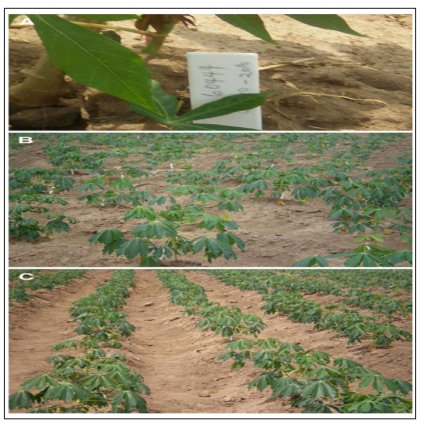
Figure 2: Confined field trials of germplasm 60444 genetically modified (GM) cassava (biofortified): A-Germplasm 60444 GM cassava with provitamin A (B-carotene) that has been harvested. B-Germplasm 60444 GM cassava with high iron at early stage C-Germplasm 60444 GM cassava with high Zn at early stage Source: Extracted from [23].
Root and tuber such as Irish potato, cassava, sweet potato and taro are the mainstay of worldwide with majority of SSA including Ethiopia which poorest society mainly depends on. Productivity per acre of these crops is 2-3 folds of cereal crops. However, perishability, toxicity, disease and insect pest susceptibility contributed to lagging hobby of producers. Today thanks to technologies there is clue which indicates partially solving of these constraints despite it also need deep emphasis yet.
The roles of contemporary technologies in improving livelihood of societies are playing great roles in broad spectrum. Genetically modified crops achieved through genetic transformation provided promising approach to produce more in crop improvement through insertion of foreign genes. This genetic modification functionality in root and tuber crops were verified and showed promising and hopeful in improving traits and boost yield for future feeding of fast increasing population. However, great attention and care should be rendered to study its environmental side effect and on other living organisms if any.
